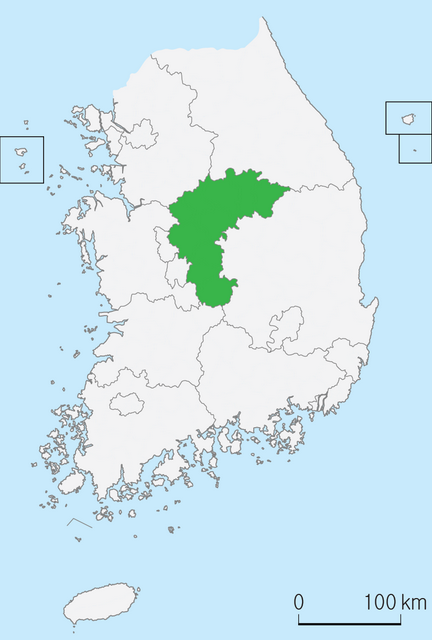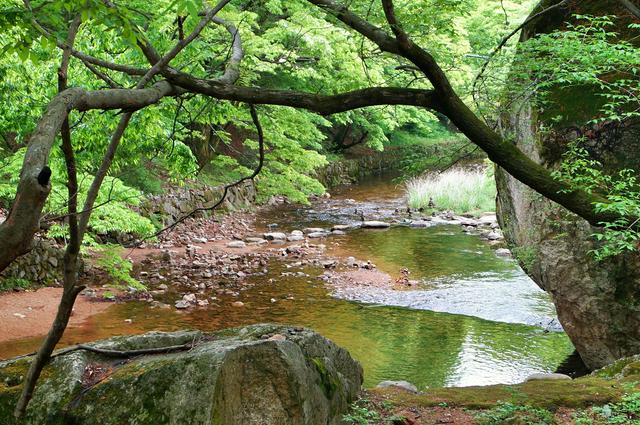North Chungcheong (충청 북도, 忠清北道 Chungcheongbuk-do), abbreviated Chungbuk, is the only landlocked province in the country. Area is surrounded by lakes and mountains.

There are only three cities in this mountainous province:
- Cheongju (청주). - the provincial capital
- Chungju (충주). - gateway to other sites
- Jecheon (제천시).
Cheongju (청주). - the provincial capital
Chungju (충주). - gateway to other sites
Jecheon (제천시).
- Danyang. - lakeside resort surrounded by three national parks
- Guinsa. - the remote, utopian headquarters of the Cheontae sect of Buddhism
- Suanbo. - hot spring and ski resort
- Songnisan National Park. - including the Beopjusa (법주사) temple, which is of significant historical and cultural importance and has reputedly the tallest Buddha statue
Danyang. - lakeside resort surrounded by three national parks
Guinsa. - the remote, utopian headquarters of the Cheontae sect of Buddhism
Suanbo. - hot spring and ski resort
Songnisan National Park. - including the Beopjusa (법주사) temple, which is of significant historical and cultural importance and has reputedly the tallest Buddha statue
Because of its geographical location, it was once the central meeting point for expressways and train lines. Although landlocked, the province has no shortage of natural attractions with a bevy of national parks and beach side views to choose from, such as the colossal Sobaeksan Mountain, Songnisan Mountain, Chungjuho Lake and Daecheongho Lake near the presidential lakeside resort. Historically it is best known for being the birthplace of the oldest book, Jikji that was printed with movable metal type. Along with its southern sister province it has a long yangban or noble class tradition. The Chungcheong nobility was made up mostly of scholars and statesmen.
As with mostly rural areas, things tend to move a little slower here. The local dialect is a mirror of how the rest of the country would characterize the Chungcheong people - forthright, gentle and more laid back. Their speech is deliberate; sounds tend to be drawn out making you lean in and listen more carefully. One way you will immediately recognize a typical Chungcheong dialect is the person will end their sentences with a "yoo" when using jondae mal instead of the standard "yeo".
Encircled by Chungju Lake and Namhang River, Danyang is one of the most picturesque towns in Korea. Nearby is the Gosu Cave. Inhabited in prehistoric times, this cave is renowned for its awe-inspiring beauty. The Early Printing Museum, where the temple Heungdeoksa in Cheongju was, is worth a look. Here the world's oldest book was printed using moveable type.
 A pleasant boat ride that stops at every nearby attraction in the area is offered at the man-made Chungju Lake. Considered to have therapeutic properties, soaking in the Suanbo Hot Springs after a full day of touring will relax you. Located at the centre of the Sobaeksan mountain range and the meeting point of countless hikers every year, Songnisan National Park is best appreciated for its cultural treasures.
A pleasant boat ride that stops at every nearby attraction in the area is offered at the man-made Chungju Lake. Considered to have therapeutic properties, soaking in the Suanbo Hot Springs after a full day of touring will relax you. Located at the centre of the Sobaeksan mountain range and the meeting point of countless hikers every year, Songnisan National Park is best appreciated for its cultural treasures.
Being the only province without a coastline, the province's cuisine is composed mainly of grains and vegetables. Barley is the most popular alternative to rice for their variety of dishes. Regional specialities include:
- sanchae bibimbap (산채 비빔밥), rice with mushroom, spinach, an assortment of roots, sprouts and other vegetables
- hobak beombeok (호박 범벅), winter squash porridge
- cheonggukjjang jjigae (청국장 찌개), bean paste stew with ground fermented soybeans
Produced in Cheongju, Cheongju Daechusul is a type of 'takju,' unrefined liquor fermented from grains. It would be in the same family as the popular 'makgeolli' and its cousin, 'dongdongju.' Carefully brewed with jujubes, glutinous rice, yeast, malt, pine needles and spring water pumped from an underground rock bed Daechusul tastes sweet with a bitter aftertaste. The alcohol content is 16 percent.
Okcheon also produces its own makgeolli, Okcheon Ulguem Makgeolli. "Ulgeum" is Korean for turmeric, which Koreans identify with curry. Look for it in yellow bottles.
